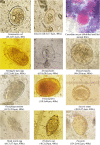Survey of intestinal parasites in swine farms raised in Western Nepal
- PMID: 37463607
- PMCID: PMC10508489
- DOI: 10.1002/vms3.1206
Survey of intestinal parasites in swine farms raised in Western Nepal
Abstract
Background: Pigs (Sus scrofa domesticus), an important domestic livestock, are generally affected by helminth and protozoan parasites. Rearing pigs in rural regions in Nepal is a common practice for subsistence farming. A cross-sectional survey was conducted to determine the occurrence of gastrointestinal parasites (GIPs) in pigs raised in Western Nepal.
Methods: A total of 200 faecal samples from commercial and smallholder farms were examined by wet mounts, flotation, sedimentation and staining techniques.
Results: The results revealed that overall 86.5% of samples were found shedding oocysts or eggs of one or more GIPs. Three species of protozoa [Eimeria sp. (26%), Entamoeba coli (25.5%) and Coccidia (29%)] and nine species of helminths parasites (Ascaris suum (32.5%), Trichuris suis (30%), strongyle-type nematode (27.5%), hookworm (26%), Fasciola sp. (17.5%), Physaloptera sp. (17.5%), Strongyloides sp. (17.5%), Metastrongylus sp. (8%) and Oesophagostomum sp. (5.5%)] were identified. Female pigs were found to have higher protozoan infection than males, but such a difference was not noticed with regard to helminth parasites. Strongyles and Oesophagostomum infection were higher in commercial farms compared to smallholder farms, whereas the prevalences of E. coli and other protozoans were higher in smallholder farms. Among the contextual factors evaluated for association, weight and gender of pigs, and annual income and gender of managers/caretakers were significantly (p < 0.05) associated with the prevalence of GIPs in pigs. The overall prevalence of certain helminths such as strongyle-type nematode and A. suum was significantly (p < 0.05) associated with the weight of pigs after adjusting other contextual factors.
Conclusions: This study detected relatively high prevalence of intestinal parasites in domestic pig facilities. Molecular epidemiological studies are essential to verify the exact zoonotic potential of parasites carried by pigs in the region. An effective periodic monitoring of GIPs of pigs needs to be carried out to minimize their further dissemination.
Keywords: Nepal; gastrointestinal parasites; prevalence; swine farms.
© 2023 The Authors. Veterinary Medicine and Science published by John Wiley & Sons Ltd.
Conflict of interest statement
Authors declare that there is no conflicts of interest.
Figures
Similar articles
-
Prevalence of gastrointestinal helminths and parasites in smallholder pigs reared in the central Free State Province.Onderstepoort J Vet Res. 2019 Apr 11;86(1):e1-e8. doi: 10.4102/ojvr.v86i1.1687. Onderstepoort J Vet Res. 2019. PMID: 31038321 Free PMC article.
-
Gastrointestinal parasites of indigenous pigs (Sus domesticus) in south-central Nepal.Vet Med Sci. 2021 Sep;7(5):1820-1830. doi: 10.1002/vms3.536. Epub 2021 May 22. Vet Med Sci. 2021. PMID: 34021721 Free PMC article.
-
Parasites of pigs in two farms with poor husbandry practices in Bishoftu, Ethiopia.Onderstepoort J Vet Res. 2015 Apr 30;82(1):839. doi: 10.4102/ojvr.v82i1.839. Onderstepoort J Vet Res. 2015. PMID: 26017194 Free PMC article.
-
Helminth parasites in pigs: new challenges in pig production and current research highlights.Vet Parasitol. 2011 Aug 4;180(1-2):72-81. doi: 10.1016/j.vetpar.2011.05.029. Epub 2011 May 27. Vet Parasitol. 2011. PMID: 21684689 Review.
-
Automated Diagnostics: Advances in the Diagnosis of Intestinal Parasitic Infections in Humans and Animals.Front Vet Sci. 2021 Nov 23;8:715406. doi: 10.3389/fvets.2021.715406. eCollection 2021. Front Vet Sci. 2021. PMID: 34888371 Free PMC article. Review.
Cited by
-
Prevalence and contributing factors of intestinal parasitic infections among school children with malnutrition in Hetauda, Nepal: A cross-sectional study.Health Sci Rep. 2024 May 27;7(6):e2146. doi: 10.1002/hsr2.2146. eCollection 2024 Jun. Health Sci Rep. 2024. PMID: 38812713 Free PMC article.
-
Prevalence of intestinal parasites in humans and domestic animals in Jirel community, Dolakha, Nepal.J Family Med Prim Care. 2024 Aug;13(8):3408-3414. doi: 10.4103/jfmpc.jfmpc_197_24. Epub 2024 Jul 26. J Family Med Prim Care. 2024. PMID: 39228571 Free PMC article.
-
Coccidia Species and Geographical Distribution in Genus Sus: A Scoping Review.Microorganisms. 2024 Dec 25;13(1):14. doi: 10.3390/microorganisms13010014. Microorganisms. 2024. PMID: 39858782 Free PMC article. Review.
-
Gastrointestinal parasites in pigs in Brazil: prevalence, risk factors, diagnosis, and extension activities.Parasitol Res. 2025 Sep 8;124(9):100. doi: 10.1007/s00436-025-08536-7. Parasitol Res. 2025. PMID: 40924232 Free PMC article.
References
-
- Amadi, A. N. , Ubiaru, P. C. , Ugagu, G. M. , Ibediugha, B. N. , Obeagu, I. A. , & Njikeonye, A. (2018). Preliminary study on the prevalence of gastrointestinal parasites of pigs managed and slaughtered in Umuahia North Local Government Area of Abia State, Nigeria. Animal Research International, 15(2), 3013–3019.
-
- Conteh, A. M. , & Gogra, B. (2019). Indigenous pig farming in rural areas of Sierra Leone: Practices, constraints and impact on livelihood. Journal of Animal Science and Veterinary Medicine, 4(4), 135–144.
MeSH terms
LinkOut - more resources
Full Text Sources



